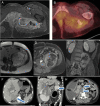Abdominal neoplastic manifestations of neurofibromatosis type 1
- PMID: 32642738
- PMCID: PMC7317050
- DOI: 10.1093/noajnl/vdaa032
Abdominal neoplastic manifestations of neurofibromatosis type 1
Abstract
Neurofibromatosis type 1 (NF1) is an autosomal dominant hereditary tumor syndrome, with a wide clinicopathologic spectrum. It is defined by characteristic central nervous system, cutaneous and osseous manifestations, and by mutations in the NF1 gene, which is involved in proliferation via p21, RAS, and MAP kinase pathways. Up to 25% of NF1 patients develop intra-abdominal neoplastic manifestations including neurogenic (commonly plexiform neurofibromas and malignant peripheral nerve sheath tumors), interstitial cells of Cajal (hyperplasia, gastrointestinal stromal tumors), neuroendocrine, and embryonal tumors (rhabdomyosarcoma). Nonspecific symptoms, multifocal disease, or coexistence of 2 or more tumor types make patients challenging to diagnose and manage. Screening for intra-abdominal tumors in NF1 patients remains controversial, and currently no guidelines are established. Management decisions are complex and often informed by single-center experiences or case studies in the literature, though the field is rapidly evolving. Thus, NF1 patients should be followed in specialist centers familiar with their wide spectrum of pathology and with multidisciplinary care including specialized pathology and radiology. This review will (1) provide a contemporaneous synthesis of the literature and our multi-institutional clinical experiences with intra-abdominal neoplasms in NF1 patients, (2) present a classification framework for this heterogeneous group of disorders, and (3) outline approaches to screening, surveillance, diagnosis, and management.
Keywords: gastrointestinal stromal tumor; malignant peripheral nerve sheath tumor; neoplasms; neurofibromatosis type 1; plexiform neurofibroma.
© The Author(s) 2020. Published by Oxford University Press, the Society for Neuro-Oncology and the European Association of Neuro-Oncology.
Figures

References
-
- Uusitalo E, Rantanen M, Kallionpää RA, et al. . Distinctive cancer associations in patients with neurofibromatosis type 1. J Clin Oncol. 2016;34(17):1978–1986. - PubMed
-
- Gutmann DH, Aylsworth A, Carey JC, et al. . The diagnostic evaluation and multidisciplinary management of neurofibromatosis 1 and neurofibromatosis 2. JAMA. 1997;278(1):51–57. - PubMed
-
- Fukuya T, Lu CC, Mitros FA. CT findings of plexiform neurofibromatosis involving the ileum and its mesentery. Clin Imaging. 1994;18(2):142–145. - PubMed
-
- Woodruff JM. Pathology of tumors of the peripheral nerve sheath in type 1 neurofibromatosis. Am J Med Genet. 1999;89(1):23–30. - PubMed
Publication types
LinkOut - more resources
Full Text Sources
Research Materials
Miscellaneous
